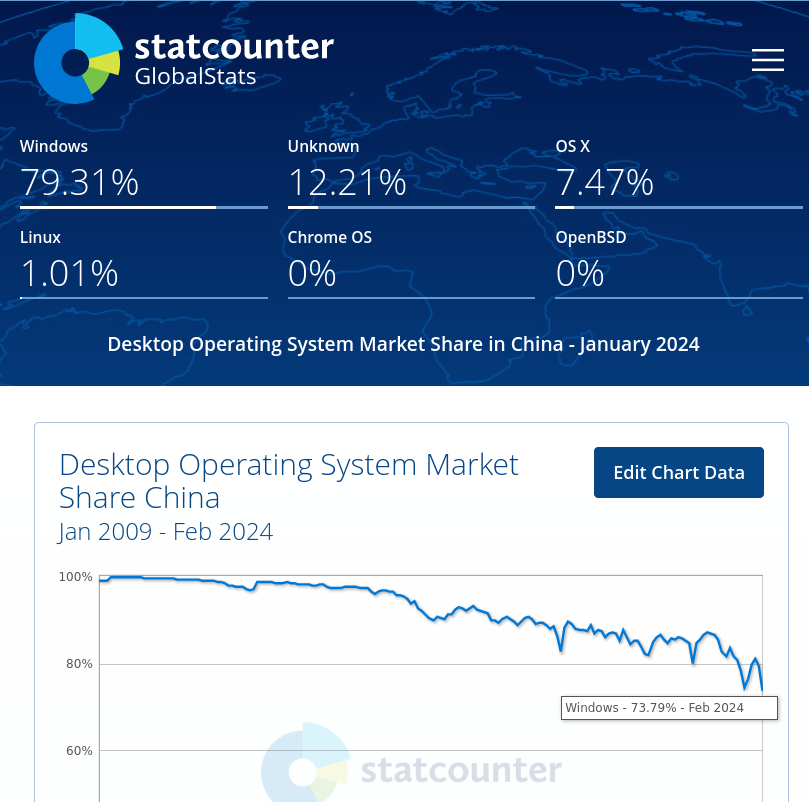Amid Trade War and Diplomatic Tensions Microsoft Windows Falls to All-Time Low in China, According to statCounter
Via.


Do you waddle the waddle?
The X242 is designed as a scalable, industrial-grade carrier board intended for commercial deployment volumes. It is built to host NVIDIA’s Jetson T5000 module, which integrates a Blackwell-architecture GPU with 2,560 CUDA cores and 96 fifth-generation Tensor Cores, delivering up to 2,070 TFLOPS (FP4 sparse) of AI performance.
The OAK 4 CS is built around Luxonis’ RVC4 vision compute platform, combining a 6-core ARMv8 CPU, 8 GB of RAM, and 128 GB of onboard storage. The product description states that the platform delivers up to 52 TOPS of AI inference performance using DSP and GPU acceleration for on-device vision workloads.
The GENESYSM-MTH6 is built around Intel Core Ultra processors (Series 1, formerly Meteor Lake), with options ranging from 15 W U-series to 28 W H-series SKUs. Supported processors include the Core Ultra 5 125U/125H and Core Ultra 7 155U/155H, providing up to 16 cores and integrated Intel Arc graphics for compute- and graphics-intensive edge applications.
According to the announcement, the E1M is designed around a common hardware and software foundation for edge AI systems. A consistent footprint and pinout allow developers to choose processing platforms based on performance, power, or cost without redesigning the carrier board, helping shorten development cycles and evaluate multiple silicon vendors.
The ICORE-3576Q38 family is available in three variants. The standard ICORE-3576Q38 targets commercial embedded systems, while the ICORE-3576JQ38 and ICORE-3576MQ38 are designed for industrial use. All three variants share the same interfaces and feature set, with differences limited to CPU frequency and operating temperature range.
Based on Alpine Linux 3.23, postmarketOS 25.12 comes with some components from the GNOME 49 desktop environment with out-of-the-box support for connecting to MTP devices, and KDE Plasma Mobile 6.5.3 with better Waydroid integration, a faster loading lockscreen, homescreen improvements, and the Plasma Camera app.
Coming two weeks after Raspberry Pi Imager 2.0.2, the Raspberry Pi Imager 2.0.3 release implements bottleneck detection and real-time progress updates showing network, decompression, or write-bound status, improves drive filtering and system identification logic on Linux, and enhances async I/O support across all platforms.
Based on Ubuntu 24.04.3 LTS (Noble Numbat) and powered by Linux kernel 6.14, elementary OS 8.1 makes the Wayland-based Secure Session introduced in elementary OS 8.0 the default, with the X11-based Classic Session as a fallback option for those who encounter issues with the Wayland-based session.
I would like to thank everyone who sent us donations; your generosity is greatly appreciated. I also want to thank all of you for your continued support by commenting, liking, sharing, and boosting the articles, following us on social media, and, last but not least, sending us feedback.
Highlights of GnuCash 5.14 include support for US Bonds (usbonds) on the New Finance::Quote module to get prices for series E, EE, or I bonds, a new Postponed column to the Scheduled Transactions list for postponing scheduled transaction instances, and the removal of the Bulgarian Lev (BGN) currency as it’s replaced by EUR from January 1st, 2026.
Coming nine months after MPV 0.40, the MPV 0.41 release brings ambient light support on Linux using sysfs ALS, tablet input support for Wayland, color representation protocol support for Wayland, clipboard writing support for Wayland, and improved default color management for gpu-next and handling on Wayland.
Highlights of Ventoy 1.1.10 include support for the AerynOS distributions, support for the musl libc environment for Ventoy2Disk.sh, improved boot support for the EXT4 file system, improved Wayland support for the LinuxGUI program, improved Windows boot support in F2 mode, and improved boot support with Kylin Server V11.
Coming more than eight months after Darktable 5.2.1, the Darktable 5.4 release adds base support for new cameras, including Canon EOS R1, Canon EOS R5 Mark II, Canon PowerShot D10 (DNG), Canon PowerShot S100V, Canon PowerShot S2 IS (DNG), Fujifilm FinePix HS33EXR, and Fujifilm X-E5 (compressed).
Via.
